Properly fitting running shoes are essential for optimal performance, comfort, and injury prevention. This guide offers expert tips on measuring, gait analysis, and selecting the right shoe for your needs.
Understanding Proper Running Shoe Fit
A proper fit ensures comfort, supports performance, and prevents injuries. Shoes should feel snug yet allow toe movement, with a secure heel and adequate space in the toe box.
How Running Shoes Should Feel
Running shoes should feel snug but comfortable, with a secure heel and enough space in the toe box for toes to wiggle. The fit should prevent slipping while allowing natural foot movement. A proper fit ensures the shoe feels like an extension of your foot, providing support without constriction. The heel should feel cupped, and the midfoot should offer a locked-down sensation. The shoes should disappear from your awareness during a run, indicating optimal comfort and fit.
Importance of Proper Fit for Performance and Comfort
A proper fit is crucial for both performance and comfort. It reduces the risk of injuries like blisters and heel pain while enhancing running efficiency. A well-fitting shoe supports natural foot mechanics, allowing for better responsiveness and energy return. Comfort is maximized when the shoe provides adequate support without constriction, ensuring a smooth and enjoyable running experience. Proper fit also prevents foot fatigue, enabling runners to perform at their best.
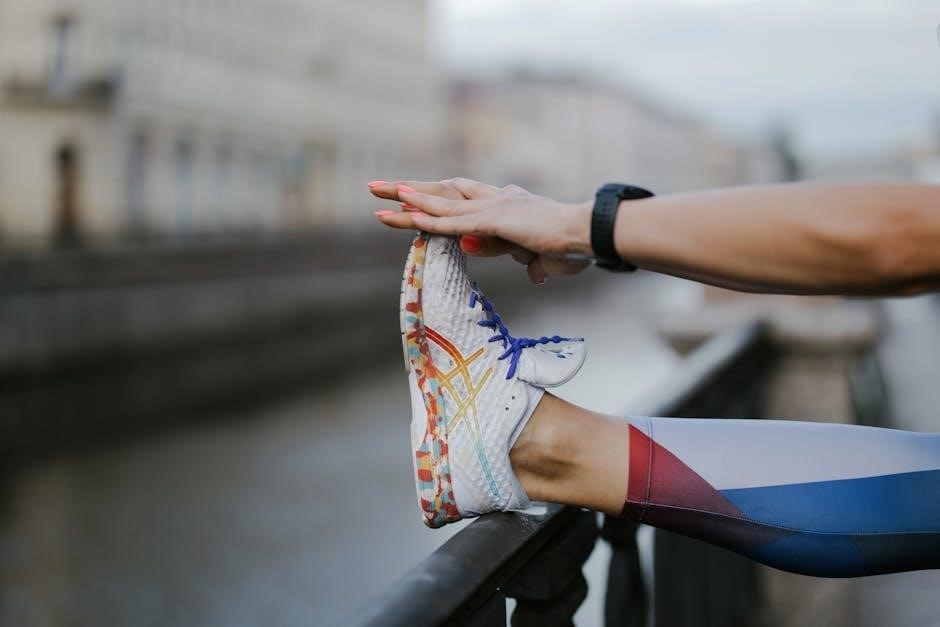
Measuring Techniques for Running Shoe Fit
Accurate measurements ensure the best fit. Measure both feet standing, using a conversion chart, and consider foot swelling. Proper sizing prevents discomfort and enhances performance.
How to Measure Foot Length and Width
To ensure accuracy, measure both feet while standing, as feet swell throughout the day. Use a Brannock device or trace your foot on paper with a ruler. For length, measure from the heel to the longest toe. For width, measure across the ball of the foot at its widest point. Always fit shoes to the larger foot and use a conversion chart to find your size. Wear running socks during measurement for the best fit.
Why You Should Measure Both Feet Standing
Measuring both feet while standing ensures accuracy, as feet naturally expand under weight. Swelling throughout the day can increase foot length, and one foot is often larger than the other. Fitting shoes to the larger foot prevents discomfort and blisters. Standing measurements reflect how feet behave during activities, providing a more reliable fit for optimal comfort and support during runs.
Using a Shoe Size Conversion Chart
A shoe size conversion chart helps standardize measurements across brands and regions. Since sizes vary, the chart ensures consistency, allowing accurate comparisons. Use it to match your foot length and width to the correct size, considering differences in branding and international standards. This tool is especially useful for online shopping, ensuring a proper fit without trying shoes on. Always account for toe room and width when converting sizes.
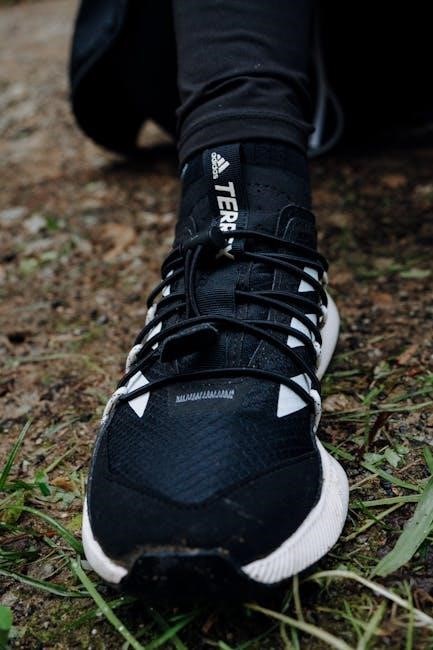
Gait Analysis and Shoe Fit
Gait analysis assesses how your foot moves during running, helping determine the right shoe support. It identifies pronation or supination patterns, ensuring optimal shoe selection for comfort and performance.
What is Gait Analysis?
Gait analysis is the assessment of how you walk or run, evaluating foot movement and alignment. It helps determine if you overpronate, underpronate, or have a neutral gait. Using video recording or force plates, specialists analyze your stride to recommend shoes that support your specific needs, reducing injury risk and enhancing performance.
How Gait Analysis Helps in Choosing the Right Shoe
Gait analysis evaluates your foot movement and pronation pattern, helping identify if you overpronate, underpronate, or have a neutral gait. This assessment, often using video or force plates, provides insights into your stride and alignment. Specialists use these findings to recommend shoes with the right level of support, cushioning, or stability, ensuring optimal performance, reduced injury risk, and personalized comfort for your specific running style.
Types of Running Shoes Based on Gait
Running shoes are categorized into three main types based on gait: neutral, stability, and motion control. Neutral shoes suit runners with a neutral gait, offering flexibility and cushioning. Stability shoes are designed for mild overpronation, providing moderate arch support. Motion control shoes are for severe overpronation, offering maximum support and stability. Each type addresses specific gait patterns, ensuring proper alignment and support to prevent injuries and enhance performance.
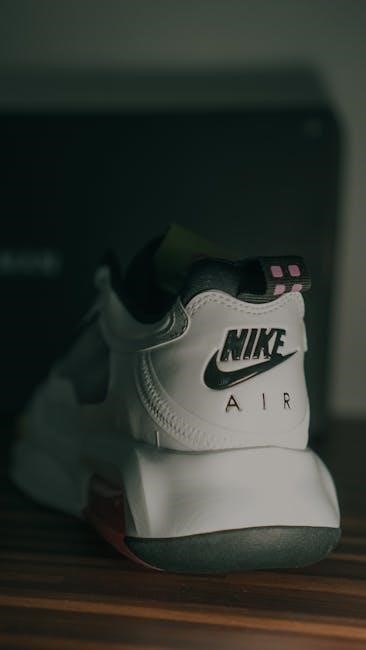
Factors Influencing Running Shoe Fit
Foot shape, running style, and personal preferences significantly impact shoe fit. Proper toe box space, heel snugness, and sock thickness also play crucial roles in ensuring comfort and support.
Foot Shape and Running Style
Foot shape and running style significantly influence shoe fit. Narrow or wide feet require specific widths, while high arches or flat feet may need more support. Running styles, such as overpronation or supination, determine the type of cushioning and stability required. Proper fit ensures natural foot movement, preventing discomfort or injury. Matching the shoe to your foot shape and running style enhances performance and comfort during runs.
Toe Box Space and Heel Snugness
Adequate toe box space allows toes to wiggle freely, preventing constriction and discomfort. The heel should feel snug but not overly tight to avoid slippage during runs. Proper toe box space ensures natural toe movement, while heel snugness provides stability. Poor fit in either area can lead to blisters, discomfort, or even injuries. Balancing these elements is crucial for optimal comfort and performance during runs.
Impact of Socks on Shoe Fit
Socks significantly influence running shoe fit. Thicker socks take up more space, reducing toe box room, while thin socks provide a snugger feel. Always try shoes with your running socks to ensure proper fit. Incorrect sock thickness can lead to a too-tight or too-loose fit, causing discomfort or blisters. Choosing the right sock thickness ensures optimal comfort and performance during runs.
Trying On Running Shoes
Try shoes in the afternoon, as feet swell throughout the day. Ensure a proper fit by wearing running socks and testing for comfort and support.
Best Time to Try On Shoes
Try on running shoes in the afternoon, as feet typically swell throughout the day. This ensures a more accurate fit. Wear the same type of socks you’ll use for running to gauge comfort and support. Proper fit is crucial, so consider consulting a shoe fitter or podiatrist for personalized advice. Testing shoes at the right time helps prevent issues like tightness or slipping during runs.
How to Test Shoes for Comfort and Support
When testing running shoes, ensure the toe box allows toe movement and the heel feels snug. Walk or jog to assess comfort and support. Avoid tightness or slipping. Wear your running socks to evaluate fit accurately. Pay attention to pressure points or discomfort. A proper fit should feel natural, with no distractions during movement. If possible, try a short run to gauge responsiveness and overall feel. Expert advice can also refine your testing process.
Importance of Wearing Running Socks
Running socks are crucial for comfort and performance. They provide cushioning, reduce friction to prevent blisters, and wick moisture to keep feet dry. Wearing the right socks ensures proper fit and prevents slippage. Always try on shoes with your running socks to gauge accuracy. Socks can also impact arch support and overall shoe feel, making them a vital component of your running setup. Choose moisture-wicking materials for optimal comfort.

Support and Stability Features
A well-fitting running shoe provides essential support and stability, ensuring your foot stays secure during runs. Proper heel snugness and arch support prevent slippage and enhance performance;
Understanding Heel Drop and Cushioning
Heel drop, the difference in height between the heel and forefoot, affects running performance and comfort. Lower drops promote natural foot motion, while higher drops offer cushioning and support. Cushioning absorbs impact, reducing strain on joints. Proper heel fit ensures stability, preventing slippage. Gait analysis helps determine ideal levels for individual needs, ensuring optimal comfort and injury prevention during runs.
How to Ensure Proper Heel and Arch Support
Ensure the heel feels snug and secure to prevent slippage. The arch should provide adequate support, with options like orthotics for additional stability. Proper lacing techniques, such as the runner’s loop, can enhance fit. Try shoes in the afternoon, as feet swell throughout the day. Consulting a podiatrist or fitter can help tailor support to your foot shape and running style, ensuring comfort and reducing injury risk.
Lacing Techniques for Optimal Fit
Proper lacing ensures a snug, secure fit without discomfort. Use techniques like the “runner’s loop” to lock the heel and evenly distribute pressure. Avoid laces that are too tight, as they can restrict circulation, or too loose, which may cause slippage. Experiment with different lacing styles to accommodate foot shape and preferences. If unsure, consult a shoe fitter for personalized guidance to achieve the perfect balance of support and comfort.
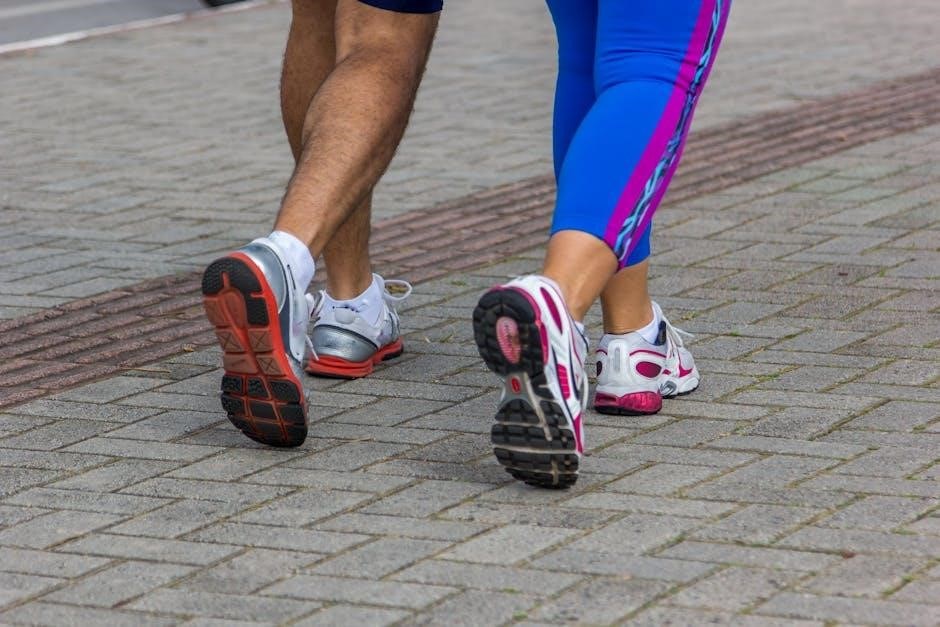
Common Mistakes to Avoid
Buying shoes too small or too big, not considering foot swelling, and ignoring gait and foot alignment are common errors that can lead to discomfort and injuries.
Buying Shoes Too Small or Too Big
Buying shoes too small can cause toe compression, blisters, and toenail damage, while too-large shoes may lead to slipping and discomfort. Proper fit ensures optimal performance and injury prevention. Try shoes later in the day, as feet swell, and get professionally measured annually to accommodate foot growth. Avoid guessing your size—use accurate measurements for the best fit.
Not Considering Foot Swelling
Ignoring foot swelling can lead to discomfort and poor fit. Feet naturally swell throughout the day, especially during runs, so trying shoes in the afternoon ensures accuracy. Neglecting this may result in tightness or blisters. Proper fit allows for toe movement and avoids constriction, preventing injuries. Always consider swelling when selecting shoe size for optimal comfort and performance.
Ignoring Gait and Foot Alignment
Gait and foot alignment play a crucial role in shoe fit. A proper gait analysis determines if you overpronate, underpronate, or have a neutral stride, guiding the choice between neutral, stability, or motion control shoes. Ignoring this leads to poor fit, discomfort, and increased injury risk. Always consult a specialist for accurate gait assessment to ensure optimal support and performance during runs.

Benefits of Proper Running Shoe Fit
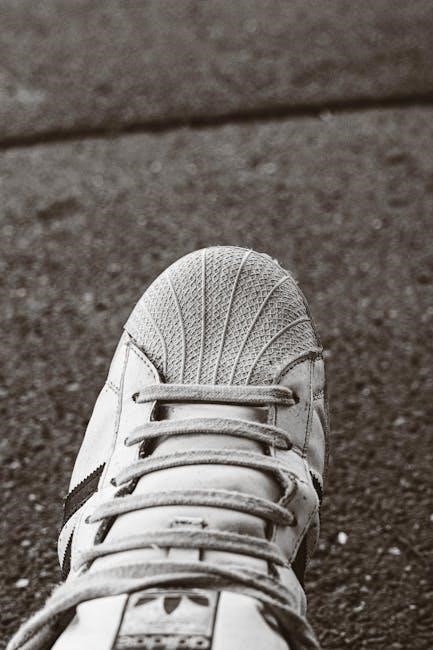
Proper fit reduces injury risk, enhances comfort, and improves performance. It allows better foot mechanics, reduces fatigue, and supports overall running efficiency, making every run more enjoyable.
Reduced Risk of Injuries
A proper running shoe fit significantly lowers the risk of injuries like nerve impingement, tendonitis, and stress fractures. It ensures natural foot mechanics, preventing excessive strain on joints and muscles, which can lead to long-term damage. Poorly fitting shoes often cause issues such as heel pain, bunions, or toe deformities, while a well-fitting pair promotes stability and support, allowing runners to perform without discomfort or risk of injury during training or races.
Improved Running Performance
A well-fitting running shoe enhances performance by allowing a natural stride and efficient energy transfer. Proper cushioning and support enable runners to maintain form and endurance, reducing fatigue. Shoes that align with your gait and foot shape optimize responsiveness, making every step feel more powerful and controlled. This leads to better overall performance, whether training or competing, by ensuring your shoes work in harmony with your body.
Enhanced Comfort During Runs
Properly fitted running shoes significantly enhance comfort during runs by preventing blisters and calluses. Ample toe box space allows toes to wiggle freely, reducing pressure points. A snug heel ensures minimal slipping, while adequate cushioning absorbs impact. Trying shoes in the afternoon accounts for foot swelling, ensuring a more accurate fit. This attention to detail makes runs more enjoyable and injury-free, keeping you focused on performance and ensuring a smooth, comfortable experience every time.
How Foot Shape and Running Surface Affect Fit
Foot shape influences shoe choice, while running surfaces demand specific features. Trail shoes offer durability, while road shoes prioritize cushioning, ensuring optimal fit for varied terrains and preferences.
Differences Between Road and Trail Running Shoes
Road running shoes are designed for smooth surfaces, offering lightweight cushioning and flexibility. Trail shoes feature rugged outsoles with aggressive tread for traction, reinforced materials for durability, and rock plates for protection. Road shoes prioritize energy return, while trail shoes focus on stability and protection from uneven terrain. Choosing the right type ensures optimal performance, comfort, and safety for your specific running environment.
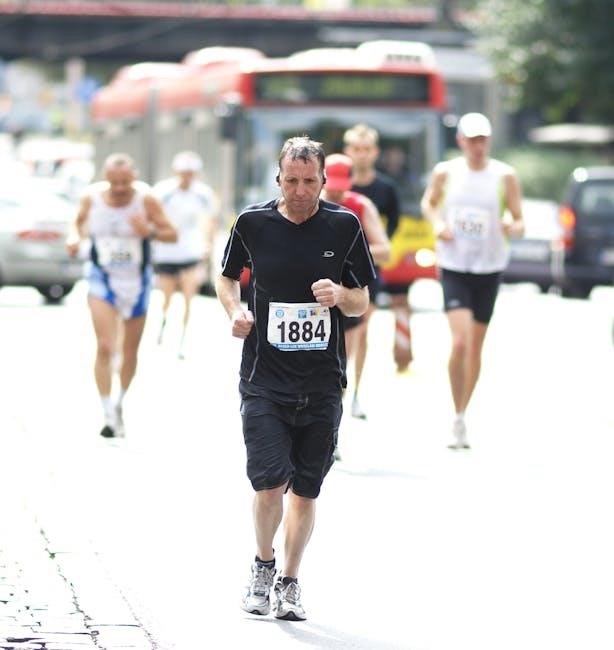
How Foot Shape Influences Shoe Choice
Foot shape significantly impacts shoe choice, as different shapes require varying levels of support and space. For instance, flat feet may need shoes with additional arch support, while high arches often benefit from more cushioning. Narrow or wide feet demand appropriately sized toe boxes to avoid discomfort or constriction. Understanding your foot shape ensures a better fit, enhancing comfort and performance during runs.
Adapting Fit for Different Running Surfaces
Running surfaces like trails, roads, or tracks require tailored shoe fits. Trail shoes need more traction and durability, with snugger fits to prevent slipping on uneven terrain. Road shoes prioritize cushioning and breathability for long-distance comfort. Ensure proper fit by matching shoe features to your running environment, as different surfaces demand varying levels of support, stability, and protection to optimize performance and reduce injury risks.
Expert Recommendations
Consult running shoe specialists or podiatrists for personalized fit advice. Utilize online fit finder tools to narrow down options based on your foot shape and running style.
Consulting a Running Shoe Specialist
Running shoe specialists provide personalized fit advice, ensuring optimal comfort and performance. They measure both feet while standing, analyze gait, and recommend shoes based on your running style and surface. Experts also offer lacing techniques and accessories for improved fit. Visiting a specialty store or podiatrist can prevent injuries and enhance running efficiency, as they tailor recommendations to your unique foot shape and needs. Proper fit is crucial for peak performance.
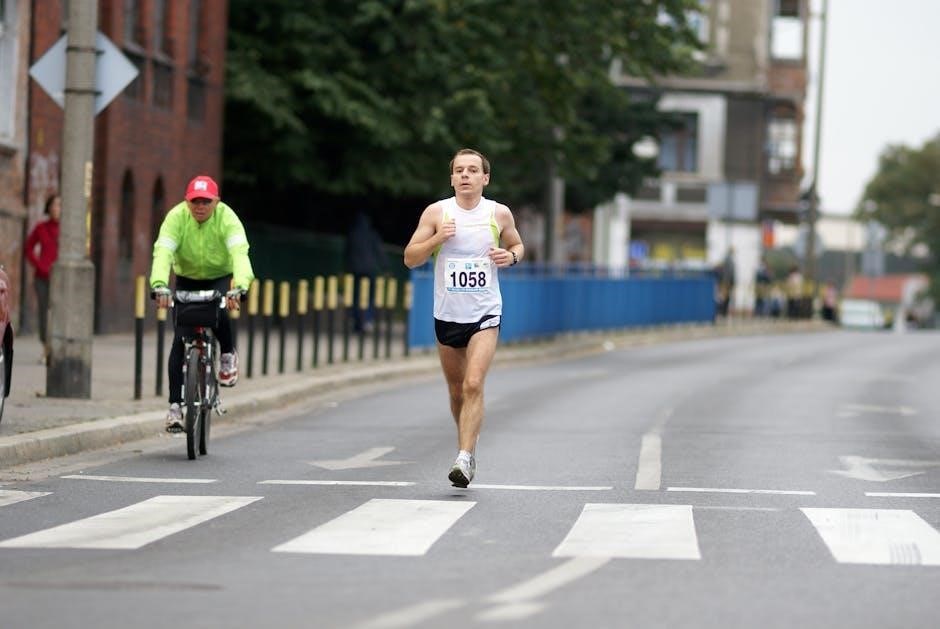
Role of Podiatrists in Shoe Fit
Podiatrists play a crucial role in ensuring proper shoe fit by analyzing foot structure, gait, and biomechanics. They provide personalized recommendations to address specific foot issues, such as pronation or flat feet. Podiatrists can also create custom orthotics to enhance comfort and support. Their expertise helps runners avoid injuries and improve performance by ensuring shoes align with their unique foot needs and running style for optimal fit and function.
Using Online Fit Finder Tools
Online fit finder tools, like the Road Runner Sports Fit Finder, provide personalized recommendations by analyzing foot shape, running style, and preferences. These tools ask detailed questions to suggest ideal shoe models, ensuring a tailored fit. Some tools even guide users to measure their feet at home using a shoe liner. They offer convenience, helping runners make informed decisions and reducing the risk of poor fit, all from the comfort of their own space.
Properly fitting running shoes are crucial for comfort, performance, and injury prevention. By understanding your foot shape, gait, and running style, you can make informed decisions. Consulting experts, using online tools, and testing shoes in-store ensure the best fit. Remember, the right shoe enhances your running experience, reducing discomfort and risks. Investing time in finding your ideal fit pays off in the long run, keeping you running happily and healthily for years to come.

